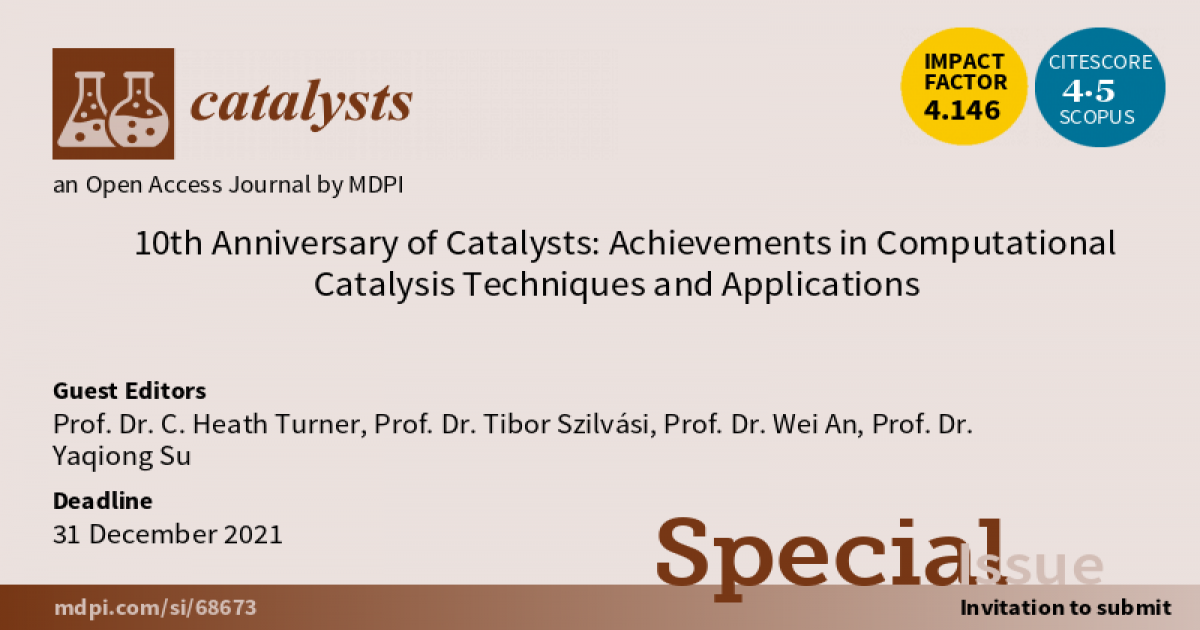- 4.0Impact Factor
- 7.6CiteScore
- 17 daysTime to First Decision
10th Anniversary of Catalysts: Achievements in Computational Catalysis Techniques and Applications
This special issue belongs to the section “Computational Catalysis“.
Special Issue Information
Dear Colleagues,
In 2021, Catalysts will reach a significant milestone in its history by welcoming its tenth anniversary. In order to celebrate this special occasion, we will be launching a Special Issue in the Computational Catalysis subsection entitled “10th Anniversary of Catalysts: Achievements in Computational Catalysis Techniques and Applications.” We will be editing a Special Issue of comprehensive reviews and particularly impactful original articles. Computational catalysis has emerged as one of the fastest growing research fields in the last decade, and it now represents a critical tool for the analysis of chemical mechanisms and active sites. As the field of computational catalysis continues to expand, the gap between models and reality is beginning to narrow. We are particularly interested in articles that investigate the secondary effects influencing catalysis and reaction mechanisms. This includes the role of structural defects, the solvation environment or neighbor-neighbor effects, deactivation events, and work that incorporates system features encountered at finite temperatures. Furthermore, we are interested in new techniques and applications that enable extended time scale analyses, as well as high throughput screening techniques that involve machine learning or descriptor-based protocols.
We would like to thank all our Editorial Board Members, Editors, Reviewers, and Authors for their great contributions and continuous support over the last decade. Please help us to celebrate our 10th Anniversary and participate by submitting your work to this Special Issue.
Prof. Dr. C. Heath Turner
Prof. Dr. Tibor Szilvási
Prof. Dr. Wei An
Prof. Dr. Yaqiong Su
Guest Editors
Manuscript Submission Information
Manuscripts should be submitted online at www.mdpi.com by registering and logging in to this website. Once you are registered, click here to go to the submission form. Manuscripts can be submitted until the deadline. All submissions that pass pre-check are peer-reviewed. Accepted papers will be published continuously in the journal (as soon as accepted) and will be listed together on the special issue website. Research articles, review articles as well as short communications are invited. For planned papers, a title and short abstract (about 250 words) can be sent to the Editorial Office for assessment.
Submitted manuscripts should not have been published previously, nor be under consideration for publication elsewhere (except conference proceedings papers). All manuscripts are thoroughly refereed through a single-blind peer-review process. A guide for authors and other relevant information for submission of manuscripts is available on the Instructions for Authors page. Catalysts is an international peer-reviewed open access monthly journal published by MDPI.
Please visit the Instructions for Authors page before submitting a manuscript. The Article Processing Charge (APC) for publication in this open access journal is 2200 CHF (Swiss Francs). Submitted papers should be well formatted and use good English. Authors may use MDPI's English editing service prior to publication or during author revisions.
Keywords
- Ab initio
- Density-functional theory
- Reaction mechanism
- Computations
- Modeling
- Kinetic Monte Carlo
- Machine learning
- Deactivation
- Electrocatalysis
- Screening

Benefits of Publishing in a Special Issue
- Ease of navigation: Grouping papers by topic helps scholars navigate broad scope journals more efficiently.
- Greater discoverability: Special Issues support the reach and impact of scientific research. Articles in Special Issues are more discoverable and cited more frequently.
- Expansion of research network: Special Issues facilitate connections among authors, fostering scientific collaborations.
- External promotion: Articles in Special Issues are often promoted through the journal's social media, increasing their visibility.
- e-Book format: Special Issues with more than 10 articles can be published as dedicated e-books, ensuring wide and rapid dissemination.

